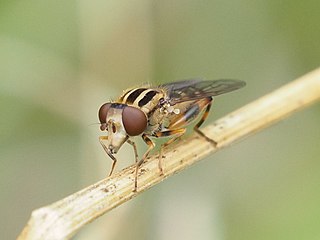
Lejops is a genus of hoverflies, closely related to the genera Helophilus, Quichuana and Mallota.

Brachypalpus is a genus of hoverflies, from the family Syrphidae, in the order Diptera. The head is triangular and produced well forwards and somewhat downwards. The thorax and abdomen with pile often rather long. The hind femur is swollen and with an obtuse spur apically and ventrally. The hind trochanters of male is spurred.
The larvae are of the rat-tailed type feeding on decaying sap under tree bark. Larvae live in decaying trees and logs. Larva and pupa have been described by Malloch.

Chrysosyrphus, the Wrinklehead flies, is a genus of hoverflies in the family Syrphidae. They are native the holarctic region. These flies are small and black., The adults feed on nectar and pollen the sources of energy and protein respectively. Larvae are unknown.

Pterallastes is a genus of bee-mimicking hoverflies. So far the genus contains only two species, one in North America and one from the Sichuan province of China.

Teuchocnemus is a genus of North American flower flies.

'Brachyopa notata , the Black-banded Sapeater , is a rare species of syrphid fly. It has been observed in Northeastern North America. Hoverflies get their names from the ability to remain nearly motionless while in flight. The adults are also known as flower flies for they are commonly found around and on flowers from which they get both energy-giving nectar and protein rich pollen. Larvae for this genus are of the rat-tailed type. B.notata larvae have not been described.
Lejops chrysostomus is the former name for a species of syrphid fly which is now called Anasimyia chrysostoma. The old name is still sometimes used for the species.

Anasimyia perfidiosus is a species of syrphid fly in the family Syrphidae, found in North America.
Blera garretti is a species of hoverfly in the family Syrphidae.

Chalcosyrphus depressus the Wide-eyed Leafwalker, is a rare species of syrphid fly observed from Idaho and Montana. Hoverflies can remain nearly motionless in flight. The adults are also known as flower flies for they are commonly found on flowers, from which they get both energy-giving nectar and protein-rich pollen.
Brachyopa perplexa , The Hairy-striped Sapeater, is an uncommon species of syrphid fly. It has been observed from the Appalachian Mountains to New York and Quebec, Canada. Hoverflies get their names from the ability to remain nearly motionless while in flight. The adults are also known as flower flies, for they are commonly found around and on flowers, from which they get both energy-giving nectar and protein-rich pollen. Larvae for this genus are of the rat-tailed type. B.perplexa larvae have not been described.
Neoascia subchalybea is a species of Hoverfly in the family Syrphidae.
Sphegina rufa is a species of hoverfly in the family Syrphidae.

Brachyopa media ( Williston, 1882), is a rare species of syrphid fly. It has been observed in the Northeastern United States. Hoverflies get their names from the ability to remain nearly motionless while in flight. The adults are also known as flower flies for they are commonly found around and on flowers from which they get both energy-giving nectar and protein-rich pollen. Larvae for this genus are of the rat-tailed type. B.media larvae have not been described.
Arctosyrphus is a genus of rat-tail maggot flies in the family Syrphidae. This genus has a single species, Arctosyrphus willingii. It was formerly a member of the genus Lejops.

Asemosyrphus is a genus of rat-tail maggot flies in the family Syrphidae. There are three described species in Asemosyrphus. They were formerly members of the genus Lejops.

Eurimyia is a genus of rat-tail maggot flies in the family Syrphidae. There are three described species in Eurimyia. They were formerly members of the genus Lejops.

Polydontomyia is a genus of rat-tail maggot flies in the family Syrphidae. The genus is monotypic, comprising a single species, Polydontomyia curvipes, also known as the dimorphic sickleleg. It was formerly a member of the genus Lejops.

Helophilina is a subtribe of rat-tail maggot flies in the family Syrphidae. There are about 19 genera and more than 180 described species in Helophilina.
Epistrophella is a genus of hoverflies in the subfamily Syrphinae, formerly treated as a subgenus of Epistrophe.












